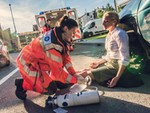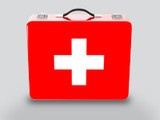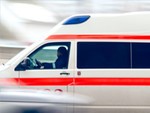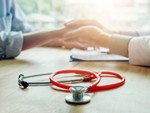The standardized rescue chain
Be it at home, at work, on the road or when you are exercising, when an accident happens, diverse persons and institutions co-operate intensively from the time when an emergency occurs to the start of medical treatment at a hospital. This process is called the “rescue chain”: Standards support its smooth functioning..
Egal ob im Haushalt, in der Arbeit, im Straßenverkehr oder beim Sport: Tritt ein Unfall ein, kommt es zwischen dem Moment des Notfalls und der Behandlung im Krankenhaus zu einem intensiven Zusammenspiel verschiedenster Personen und Institutionen. Diesen Verfahrensablauf nennt man "Rettungskette": Standards unterstützen ihren reibungslosen Ablauf.

The individual elements of the rescue chain interlock like real chain links. They aim at giving the aid required to victims already at the accident scene and at making sure that they receive medical treatment within the shortest time possible. First aiders are only active in the first three steps of the rescue chain.
At the end of the chain, professional rescue services combine emergency medical care with transport to a hospital where medical treatment can be continued.
 Immediate lifesaving measures
Immediate lifesaving measures
Immediately after finding an injured person, the first aider takes several actions. These include measures to secure the site of the accident and lifesaving measures, such as stopping severe bleeding.
Particularly in case of open wounds, it is important to wear single-use gloves for your own protection. Their tightness and minimum shelf life is ensured by ÖNORM EN 455 on medical gloves for single use.
Emergency call
When the person injured is well secured and has received first aid, the emergency call is made to alert the rescue service. For such cases, it is good to know the emergency call numbers by heart or to have them ready on your mobile phone.
In Austria, you can contact the fire service at 122, the police at 133 and the ambulance service at 144. You may also use the single European emergency call number 112. It is the same in all European countries and is given priority in the telephone network. The calls made are routed to the nearest control centre both in Austria and other European countries.
To ensure that help comes quickly, you should give the following information to the dispatcher:
1. Where is the site of the accident?
City, street, number, street corner, kilometre stone.
2. What happened?
Traffic accident, fire, accident involving electricity...?
Are persons injured trapped in a car?
Is the road blocked?
Is a lorry carrying dangerous goods involved?
3. How many persons are injured?
How many persons injured are at the scene of the accident?
4. Who makes the call?
Indicate your own name and telephone number.
Important: Only ring off when the dispatcher asks you to do so.
 First aid
First aid
When all the facts have been completely communicated, further first aid measures can be taken, such as placing the injured person in the proper position.
In case of a car accident, you will find everything you need for providing first aid in the first-aid kit that has to be carried on every vehicle.
The number of the best-known first-aid standard, ÖNORM V 5101,
is clearly shown on the standardized first-aid kits.
ÖNORM V 5101 defines requirements for the case itself: It has to adequately protect the first-aid material and must not be made of materials that could affect the usability of the items contained in it in any way, for example due to corrosion.
Moreover, the box has to be temperature-resistant and fuel-resistant, shock-proof and dust-proof. If the lid does not come with a rubber seal, the first-aid material has to be protected additionally, for example, by sealed plastic bags. To make sure that the use of the first-aid kit does not lead to further injuries, the case must not have any sharp edges and corners.
The type and quantity of first-aid materials to be included is clearly specified (as minimum requirements): For example, the kit should contain a space blanket (210 x 160 cm), bandage scissors and four triangular bandages.
- ÖNORM K 2122 on triangular bandages lays down that these bandages must have the form of an isosceles triangle and must be individually wrapped. The edges of the triangular bandage do not fray and it has to be drapeable for first-aid purposes.
- Die ÖNORM K 2121 requires that first-aid scissors have to be unbreakable and must not get stuck during cutting. The knob at the tip of the scissors prevents injuries to the skin. Just like the handles, this knob is made of synthetic material.
Important information on first-aid kits to be carried on vehicles:
- According to legislation, every vehicle must have a first-aid kit on board. To make sure that you buy a high-quality product containing all the items required, check whether the first-aid kit complies with ÖNORM V 5101.
- Every first-aid kit comes with a to-be-used-by date. Past that date, the first-aid kit should be replaced.
- There is a special first-aid kit for single-track vehicles according to ÖNORM V 5100. In this case, too, you should buy a kit in line with the ÖNORM standard.
 Medical support/transport
Medical support/transport
After the provision of first aid, the emergency medical service will usually have arrived to take care of the injured person.
ÖNORM EN 1789 on medical vehicles and their equipment categorizes the different types of ambulances. An "emergency ambulance" (type B) is usually dispatched in case of road accidents. It is designed and equipped for the transport, basic treatment and monitoring of patients. To ensure that patients are treated as promptly as possible at the scene of an accident, it is equipped like a "mobile intensive care unit".
To protect the patient's privacy during treatment, external windows must be screened according to ÖNORM EN 1789. Further provisions aimed at guaranteeing patent safety inside the vehicle are:
- The materials lining the roof, side walls and doors are impermeable to disinfectants.
- Edges of surfaces located in the patient compartment are designed and/or sealed in such a way that fluids cannot infiltrate.
- Exposed edges that could easily come into contact with the hands, legs or head of the occupants have a radius of curvature of more than 2.5 mm.
- Drawers are secured against self-opening.
The emergency ambulance has flashing blue lights and sirens. To get to the nearest hospital quickly, an ambulance loaded to permissible gross vehicle mass can accelerate from 0 km/h to 80 km/h within 35 seconds according to ÖNORM EN 1789.
 Medical treatment
Medical treatment
Treatment at a hospital completes the rescue chain. There are numerous ÖNORM standards ensuring optimum patient care.
ÖNORM H 6020 on ventilation and air conditioning plants for locations for medical use provides for clean indoor air in hospitals. This prevents that infections spread or pathogens are dispersed.
Another important "hygiene standard" is ÖNORM EN 556 "Sterilization of medical devices". This European Standard requires that adventitious microbiological contamination of a medical device is minimized.
To guarantee quality assurance during patient care, the working group "Quality Improvement in Healthcare and Nursing" developed several ONR documents on quality management in nursing. One of them is ONR 116004 "Nursing information report on shift change". Its objective is to ensure that nurses working the next shift are informed of important patient details and special incidents and observations during the previous shift.
Only as strong as the weakest link
Calmness, diligence, considerateness and competence – those are the qualities that well-trained first responders should have: Backed up by professional help and the indispensable support of ÖNORM standards, the rescue chain saves lives day by day.
Bibliography
- ÖNORM EN 455 Medical gloves for single use;
- Part 1: Requirements and testing for freedom from holes;
- Part 2: Requirements and testing for physical properties;
- Part 3: Requirements and testing for biological evaluation
- ÖNORM V 5101 First aid equipment for multi-track motor vehicles – Requirements, tests
- ÖNORM V 5100 First aid equipment for single-track motor vehicles - Requirements, tests
- ÖNORM K 2121 First-aid-scissors - Dimensions, requirements, testing
- ÖNORM K 2122 Triangular bandage for first aid - Dimensions, requirements, testing
- ÖNORM EN 1789 Ventilation and air conditioning plants for locations for medical use - Design, construction, operation, maintenance, technical and hygienic inspections
- ÖNORM EN 556 Sterilization of medical devices - Requirements for medical devices to be designated "STERILE";
- Part 1: Requirements for terminally sterilized medical devices;
- Part 2: Requirements for aseptically processed medical devices
- ONR 116004 Nursing information report at shift change
